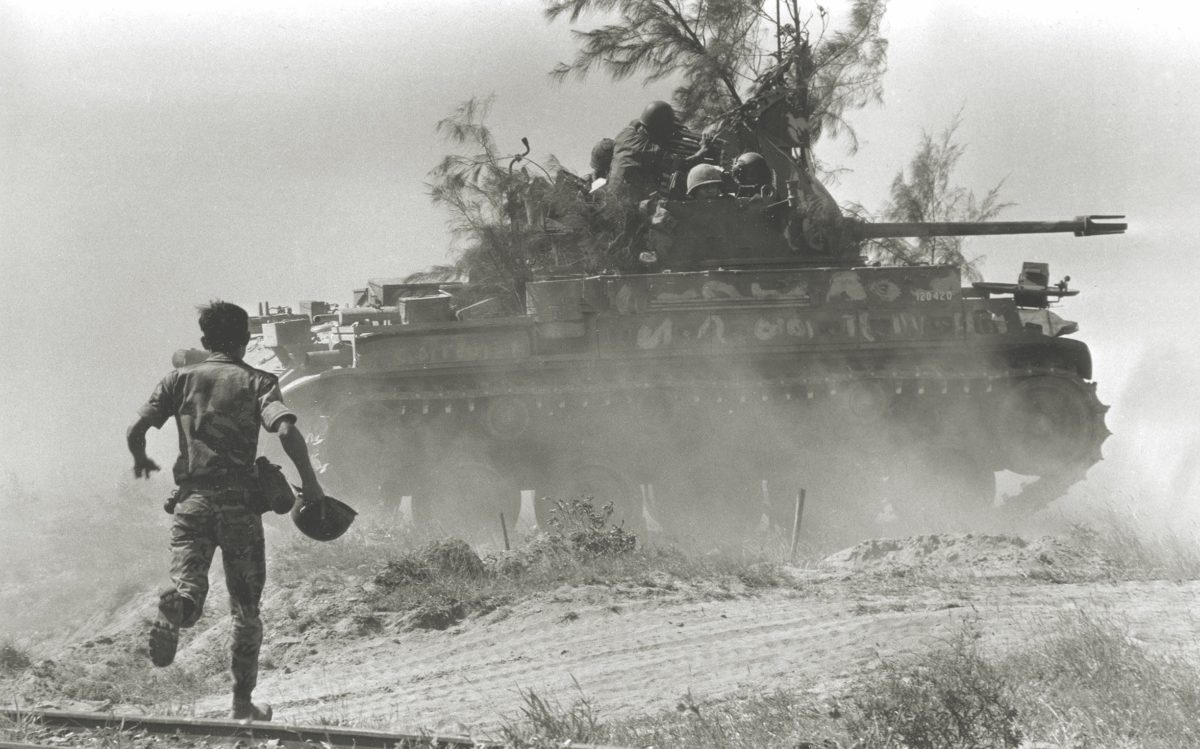Close to enemy sanctuaries north of the Demilitarized Zone and in neighboring Laos, Quang Tri province was a constant battleground. North Vietnam’s Communist Party Politburo members called it the “blazing front.” Today the old citadel fortress in Quang Tri city, the capital of South Vietnam’s northernmost province, is a memorial park dedicated to the North Vietnamese Army’s 1975 victory over the so-called “Saigon regime and its imperialist allies.”
The town and citadel were restored in the early 1980s when Communist Party Secretary Le Duan designated Quang Tri a “valiant revolutionary city.” It is a popular attraction for school children, aging NVA veterans and foreign tourists. Tour guides extol the heroism of the citadel’s communist defenders during the 1972 Spring-Summer Offensive and decry the tonnage of American bombs dropped, calling it “wanton desecration.”
They don’t tell tourists that the NVA overran the citadel on May 1, 1972, and South Vietnam’s marines successfully recaptured it five months later.
The attack to oust the NVA from Quang Tri city was the longest single battle of the Vietnam War—lasting 81 days, June 28-Sept. 16, 1972.
The opening salvo of North Vietnam’s offensive occurred on March 30, the Thursday before Easter. Commonly called the Easter Offensive, it was the largest offensive of the war. The communists attacked with conventional large army units aiming for a decisive victory, eschewing the guerrilla and small-unit fighters previously used to draw out the conflict and wear down the Americans until they tired of the war and left. The protracted conflict strategy was discarded in favor of a “go-for-broke” gamble to decisively defeat the Army of the Republic of Vietnam and topple President Nguyen Van Thieu’s government.
The Communists’ “Go For Broke” Land Grab
NVA forces stormed across the DMZ and out of Laos along Highway 9, heading for the former imperial capital of Hue, the cultural hub of South Vietnam—the first of three assaults in different regions of the country. At dawn on April 3, the NVA attacked firebases in the Central Highlands, a precursor to striking Kontum city with the ultimate goal of severing the country at its midsection. Farther south four days later, in the area around Saigon, the NVA overran Loc Ninh, a well-defended outpost on the Cambodian border, and encircled An Loc, only 60 miles from the capital.
The northern NVA juggernaut, 30,000-40,000 troops from three battle-toughened divisions (the 304th, 308th and 325C), accompanied by 200 tanks and air defense batteries, struck a thinly stretched brigade of the Vietnamese marine corps and the ARVN 3rd Division. The commander of South Vietnam’s forces in the northern provinces, Lt. Gen. Hoang Xuan Lam, head of the army’s Da Nang-based I Corps, disregarded intelligence reports indicating that enemy had massed large formations across the DMZ and directed a rotation of troops between two 3rd Division firebases on March 29. His ill-timed order added to the turmoil when the NVA attacked the next day.
The South Vietnamese marines and the 3rd Division manned positions just south of the DMZ and in the western foothills. All were under heavy attack on Easter Sunday, April 2, when a disaster occurred. ARVN Lt. Col. Pham Van Dinh, commander of the 3rd Division’s 56th Regiment, surrendered his entire unit and Camp Carroll, a former U.S. Marine Corps firebase. Dinh made no attempt to destroy large ammunition stocks or disable more than 20 artillery pieces, including four 175 mm guns.
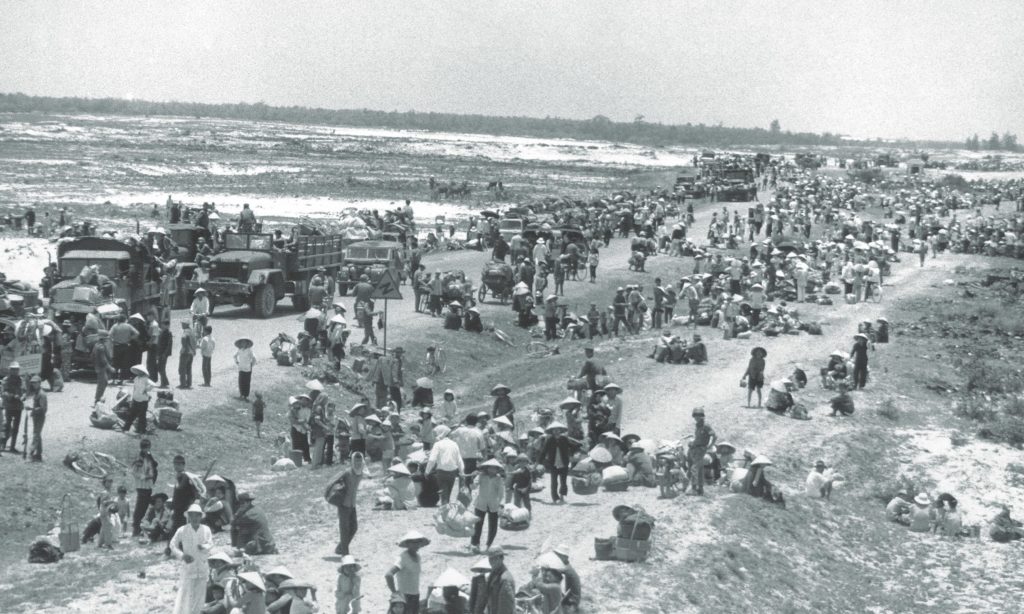
Two U.S. Army regimental advisers, Lt. Col. Bill Camper and Maj. Joe Brown, sent a terse radio message stating they were leaving. For security reasons they did not say the 56th Regiment was surrendering en masse. A recently arrived lieutenant colonel, far from the action, sent a frantic order: “Stay at your post!”
He did not understand that the judgment of advisers on the ground was to be accepted without question. Camper and Brown disregarded the command, avoided capture and escaped aboard a U.S. Army CH-47 Chinook transport helicopter piloted by Capt. Harry Thain, who received a Silver Star for the daring rescue.
The loss of Camp Carroll precipitated a general withdrawal to positions near the town of Dong Ha. South Vietnamese delaying actions provided some respite, and U.S. airstrikes slowed the invaders. However, attempts to establish a cohesive defense were frustrated by I Corps commander Lam’s flurry of conflicting and uncoordinated orders. On April 28, Dong Ha fell. Three days later Quang Tri city was abandoned by disheartened, retreating troops.
Highway 1 leading out of town was littered with the flotsam of war as soldiers and civilian refugees fled south.
Panic ensued when the NVA fired on the columns. Wounded were left where they fell. Vehicles of every type were abandoned. The leaderless rabble, a mix of soldiers and civilians, streamed into Hue and created chaos with drunken rampages and looting. The South Vietnamese marines retained their discipline and blocked the NVA advance with a steadfast defensive line along the My Chanh River, 15 miles from Hue.
The early communist successes reinforced the optimism of Politburo war hawks and marginalized members who had counseled caution. Le Duan, leader of the militant faction, was adamant that the political climate in the United States would prevent a strong response from President Richard Nixon because 1972 was a presidential election year and the American public was viewed as war weary. That was a gross misreading of the U.S. president.
At this point in the war, however, the options for a strong U.S. response were limited. On April 30, 1972, there were 68,100 American troops in Vietnam, down from a high of 543,100 in April 1969. That year the Nixon administration initiated a Vietnamization program, which gradually withdrew U.S. troops while shifting ground combat responsibilities to the South Vietnamese. Only two U.S. combat brigades remained, one in northern South Vietnam and one in the Saigon region, although their main mission was protecting U.S. air bases and logistical facilities.
Nixon ruled out reintroducing ground troops but retaliated with air power. He dispatched additional aircraft to Southeast Asia, resumed bombing “up north” and ordered the mining of North Vietnam’s seaports. Eventually, 206 B-52 bombers and more than 800 jet fighters, U.S. Air Force and carrier-based aircraft, were available for the fight. Yet in early May, South Vietnam was in grave peril.
South Vietnamese Forces Rebound
The loss of Quang Tri and rioting in Hue convinced Thieu that Lam had to go. The president replaced him with Lt. Gen. Ngo Quang Truong, commander of the Mekong Delta forces and considered the country’s best soldier. Truong and trusted assistants arrived at I Corps in less than 24 hours.
He set about restoring order, improving defenses and planning a counterattack.
The new commander set the tone when he moved the I Corps main command from Da Nang to Hue’s citadel, which had been a small forward command post manned by just a few officers and U.S. advisers. Lam visited the post but always returned to his Da Nang headquarters for an afternoon tennis match and dinner at home. Officers assigned to the First Regional Assistance Command, the I Corps advisory team, called Lam “the absentee warlord.”
The My Chanh River line needed reinforcement. Truong appealed to Thieu for additional troops. On May 8, the 2nd Airborne Brigade arrived and strengthened the marine line. Two weeks later, the 3rd Airborne Brigade and the division headquarters were flown to Hue. The best units—the Marine Division, the Airborne Division and the ARVN 1st Division—were now under Truong’s command.
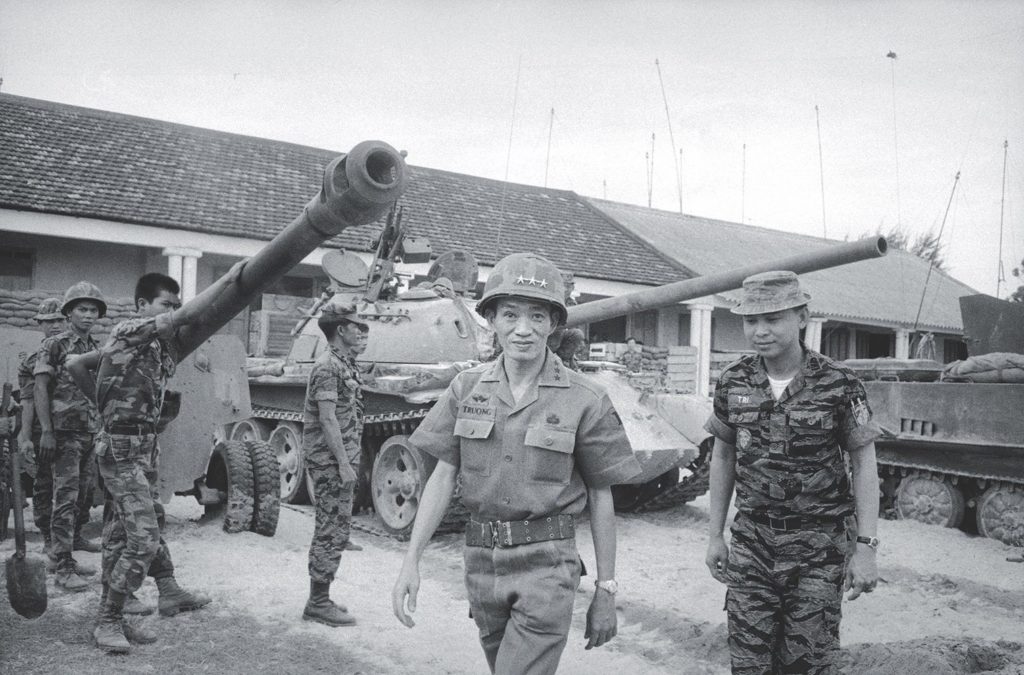
A stabilized front allowed the general to become more aggressive. Brigade 369 of the South Vietnamese marines initiated a two-battalion airmobile assault in the NVA rear just south of Quang Tri city. Two days later, on May 15, the ARVN 1st Division retook the old U.S. firebase Bastogne, strengthening the western approach into Hue. South Vietnamese troops continued to battle their adversary, and American advisers used U.S. airstrikes with devastating effectiveness.
The I Corps counteroffensive to push the enemy back across the DMZ, code named Lam Son 72, went through multiple iterations. Thieu directed Truong to recapture Quang Tri city, the only provincial capital in enemy hands, before advancing farther north. The town had no strategic value, and Truong wanted to bypass it, destroy NVA units and retake lost terrain, but the president’s order condemned the airborne and marine divisions to a bloody urban brawl.
Elaborate deception measures were employed to confuse the enemy about the time and location of the attack. A parachute drop and an amphibious landing in the enemy rear were two ruses that were “leaked.” The deceptions, however, weren’t particularly effective because the NVA headquarters in the region received detailed information about the offensive from a spy on the I Corps staff.
A “Bloody Fight”
Lam Son 72 kicked off on June 28 when marines and paratroopers made a night assault across the My Chanh River. Even though the plan had been compromised, they faced limited resistance. Encouraged, senior ARVN officers expected to secure Quang Tri city in nine days. The projection was wildly off the mark.
The advancing troops were aided by B-52 strikes, massive air support, U.S. naval gunfire and an airmobile assault by two battalions of South Vietnamese paratroopers and two battalions of Vietnamese marines, who landed behind the main line of resistance. Even so, the Airborne Division took a week to reach the outskirts of the city. The measured pace gave the enemy time to fortify the citadel. Built in 1824, the fort’s four sides measured 1,640 feet in length and were all protected by a wide moat. The thick brick walls were nearly 30 feet high with a tower at each corner of the square.
The Airborne Division commander, Lt. Gen. Du Quoc Dong, ordered the 2nd Brigade, consisting of three battalions of 2,000-plus paratroopers, to take the town. Col. Tran Quoc Lich assured the general that his brigade would do it quickly and stocked bottles of vintage champagne in anticipation of a victory celebration. Despite those assurances, Lich insisted on a cautious advance.
Maj. Le Van Me, an extraordinarily capable officer who commanded the brigade’s lead unit, the 11th Airborne Battalion, knew Lich’s caution had cost his battalion the initiative. Me’s U.S. adviser, Capt. Gail “Woody” Furrow, told another adviser: “We had ’em on the run! We should bypass that town [Quang Tri] and head to the DMZ.”
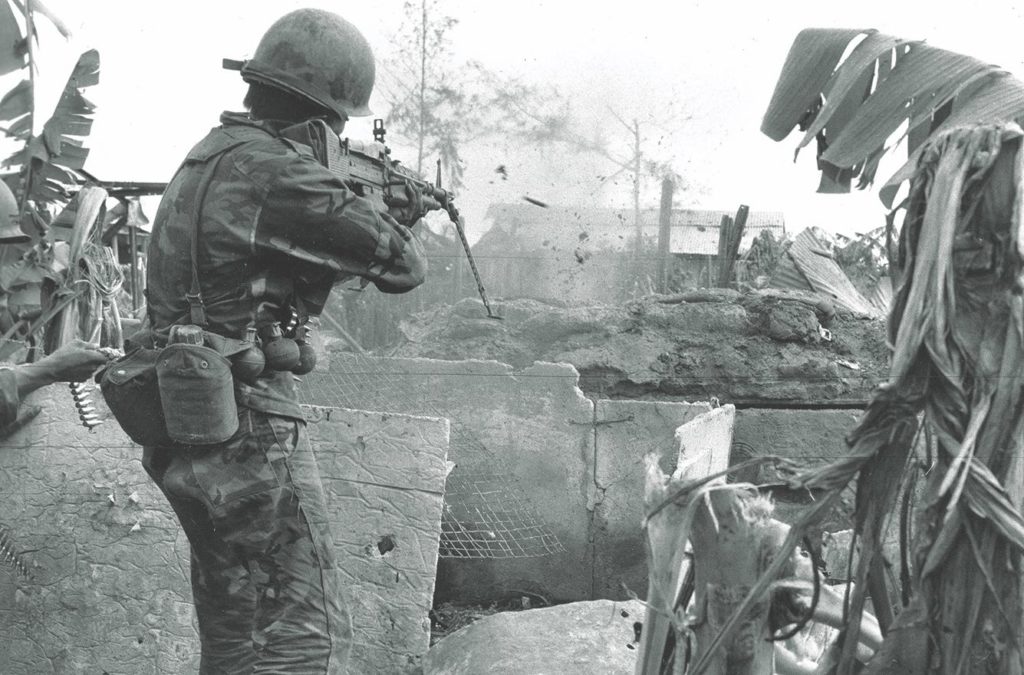
The NVA commander in the region, Lt. Gen. Tran Van Quang, knew Thieu would do whatever it took to recover the provincial capital. To ensure a bloody fight, he shifted several infantry regiments into the citadel and used another to construct fortifications inside in the city. Mortars and artillery tubes, particularly Soviet-made 130 mm field guns, were repositioned to provide maximum fire support. The 130 mm guns sent 70-pound projectiles about 17 miles, well beyond the range of the 105 mm and 155 mm howitzers on the South Vietnamese side. NVA artillery and mortars inflicted the bulk of the South Vietnamese casualties.
The 2nd Airborne Brigade assault commenced on July 10. Two battalions, the 6th and the 11th, attacked from the south, while the 5th Airborne Battalion made the main thrust from the northeast. The 5th and 6th Airborne battalions, which had arrived on June 25, were understrength from fighting in An Loc from April through mid-June. Capt. Earl Isabell, an adviser with the 5th Battalion, later said: “We were designated the main attack but weren’t given additional troops. We needed several more companies. New recruits had just arrived but were barely trained. Plus, experienced leaders lost in An Loc had not been replaced.”
“We were at a hell of a disadvantage.”
The 6th and 11th Airborne battalions gained footholds in the outskirts of the city, but the NVA fought from house to house, giving ground only grudgingly. Progress was measured in yards and buildings seized. The Marine division’s 1st Battalion launched an airmobile assault about a mile northeast of Quang Tri city the morning of July 11 to stop traffic on Route 560, the communist defenders’ main supply line, paralleling the Thach Han River. The battalion was transported by 34 U.S. Marine Corps helicopters and escorted by six U.S. Army Cobra attack helicopters.
The operation was supported by naval gunfire and B-52 strikes but still faced heavy opposition. A hail of small-arms fire and SA-7 surface-to-air missiles greeted the helicopters. One CH-53 Sea Stallion and two CH-46 Sea Knight helicopters carrying South Vietnamese marines were shot down. One chopper inadvertently landed near a well-camouflaged NVA T-54 tank. A Cobra armed with anti-tank missiles knocked out the tank.
Maj. Nguyen Dang Hoa, commander of the 1st Battalion, and his adviser, U.S. Marine Capt. Lawrence Livingston, led assaults on July 11 that destroyed NVA fortifications blocking the advance. Livingston was awarded the Navy Cross for his gallantry. The battle continued for three days. By July 14, Route 560 was closed to enemy traffic. The NVA had to find an alternative way to resupply its troops in Quang Tri.
The 5th Airborne Battalion made the main attack on the night of July 11. Preparatory artillery fire and 18 U.S. Air Force sorties softened the citadel’s fortifications. Nevertheless, the NVA defenders stopped the 5th Battalion short of the citadel wall. Friendly losses were 25 dead and more than 100 wounded.
A ban on U.S. airstrikes within the city was instituted on July 15 because Thieu wanted Quang Tri recaptured without American assistance. He was perturbed by reports that U.S. air power had saved the day at An Loc and Kontum. Over Truong’s objections, an imaginary circle was drawn around the city. U.S. airstrikes were prohibited within that area.
Like “Berlin in 1945”
The NVA, not content to remain on the defensive, staged attacks to disrupt the efforts of ARVN units to coordinate their operations. It attacked the 5th Battalion on July 15 and almost overran the command post. For an unexplained reason the attack was halted when success was within the NVA’s grasp. Two days later, a similar attack struck the 6th Battalion, resulting in hand-to-hand combat before the North Vietnamese withdrew.
ARVN paratroopers pressed forward, but gains were limited and casualties mounted. The communists spared no resources to support their defense because holding Quang Tri was Hanoi’s top priority. Although Route 560 was blocked, ferries on the Thach Han River shuttled men, supplies and replacement equipment to the citadel, ensuring that the NVA maintained its numerical advantage. Meanwhile, the Saigon government, scraping the bottom of the personnel barrel, struggled to keep up with requests for replacements.
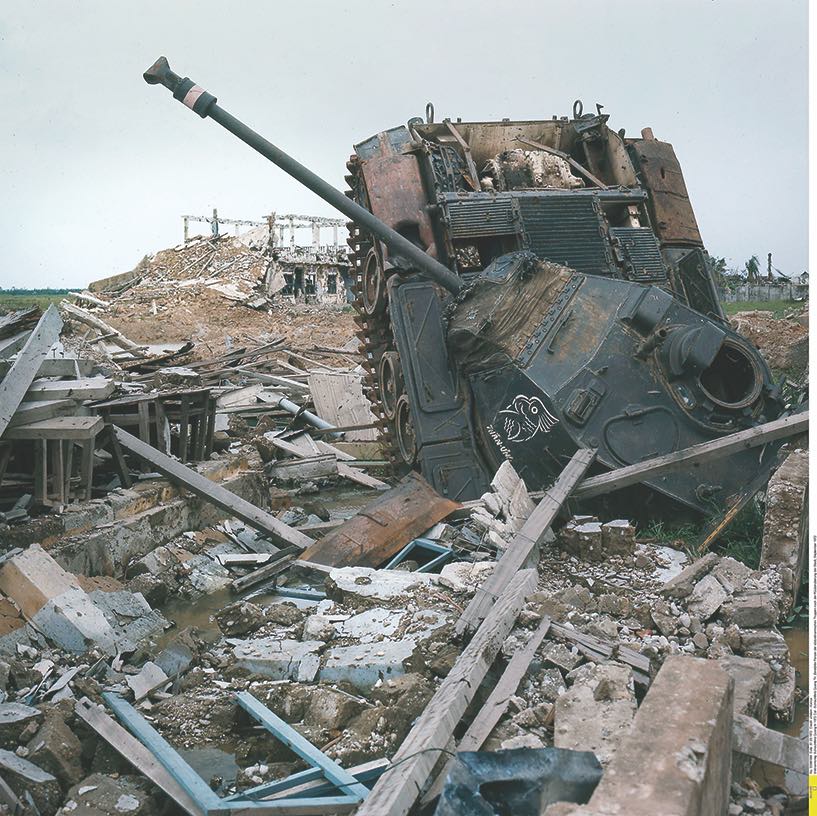
The 2nd Airborne Brigade commander was directed to launch another attack. This time the 5th Battalion was reinforced with two additional companies from the elite 81st Airborne Ranger Battalion and a tank platoon. Before the night attack on July 23, a U.S. Air Force F-4 Phantom was permitted to drop a 2,000-pound laser-guided bomb on the citadel’s northeast rampart, allowing the 5th Battalion to surge into the fortress. When daylight came, the U.S. air restriction was again imposed, and the South Vietnamese air force was called upon to help expand the penetration. One plane accidentally dropped three 500-pound bombs amid the paratroopers, killing 45 and seriously wounding 100. The 5th Battalion was forced to withdraw, ending the attack.
The two-week fight annihilated the 2nd Airborne Brigade. The 5th Battalion was the hardest hit. The 600-man unit suffered 98 killed and 400 wounded. The other two battalions were in no better shape. Four of six American advisers were wounded and hospitalized.
The Vietnamese Marine Division relieved the Airborne Division on July 27. One U.S. Marine adviser was startled by what he saw at Quang Tri.
“The once prosperous city resembled Berlin in 1945. Artillery and bomb craters were everywhere. Most structures were completely destroyed. Only the shells of sturdy buildings were still upright.”
Most marines believed they would quickly prevail where the paratroopers had failed. Their optimism was soon dashed when the initial attack floundered after running up against an entrenched, numerically superior force. U.S. Marine Maj. Richard Rothwell, an adviser with the Vietnamese Marine 5th Battalion, blamed part of the problem on the Airborne Division’s failure to secure the marines’ left flank. Several old forts west of Highway 1 were manned by the NVA and said to be firing on the advancing marine units. Earlier, Me, the 11th Airborne Battalion commander, had stated that the forts were too far away to hinder an advance along the axis used by the marines.
Regardless, the I Corps staff failed to assign responsibility for the forts and establish exact boundaries between the two divisions. These were major oversights in conventional warfare’s standard operating procedures, a result of years of small-unit operations and the corps staff rarely operating in a tactical environment.
An attack on Aug. 3 also bogged down. Thieu was forced to lift restrictions on U.S. airstrikes within Quang Tri, but that decision made little difference as the battle evolved into duels that pitted South Vietnamese artillery and U.S. airstrikes against NVA artillery. The Marine Division simply did not have sufficient forces to overcome the enemy. Brig. Gen. Bui The Lan, the division commander, needed assistance.
GET HISTORY’S GREATEST TALES—RIGHT IN YOUR INBOX
Subscribe to our HistoryNet Now! newsletter for the best of the past, delivered every Monday and Thursday.
Throughout August house-to-house fighting and continual artillery barrages caused more South Vietnamese losses. Since March 30, the 15,000-strong Marine Division had suffered 1,358 men killed and 5,500 wounded. Fighting took a similar toll on their U.S. advisers. In early July, the Marine Advisory Unit had to make an urgent request for nine officers to replace casualties.
Lan’s repeated pleas for more troops were answered on Sept. 8, when the three battalions of the 1st Ranger Group relieved Marine Brigade 147 north of the city, freeing more battalions for the assault. Lan now had six battalions, four in the south and two in the north, to commit to the task. He drew a boundary through the middle of the citadel, placing Brigade 147 in the north and Brigade 258 in the south. The 6th Battalion was directed to attack from the southeast.
To draw the enemy’s attention away from Quang Tri, the U.S. 7th fleet organized a fake amphibious landing. The 9th Marine Amphibious Brigade went through all the motions, including false radio traffic, reconnaissance of landing beaches and embarking 400 ARVN rangers aboard U.S. landing craft. On Sept. 9, naval gunfire, tactical air sorties and a B-52 bomb strike pummeled the beach due east of Quang Tri city. When the bombing stopped, NVA troops moved out of their bunkers to confront the landing forces. They were caught in a barrage of naval gunfire and sustained heavy losses. Amphibious vehicles and U.S. Marine helicopters approached the shoreline but turned back short of the beach.
A Hard-Earned Victory
While the 9th Marine Amphibious Brigade held the enemy’s attention, the attack on the citadel began. The NVA had responded to the 7th Fleet threat by repositioning some of its artillery, which reduced its fire on the attacking brigades. The South Vietnamese marines still faced a tough fight. Rubble created by the bombardment made excellent defensive positions, and a labyrinth of NVA tunnels withstood some of the fire.
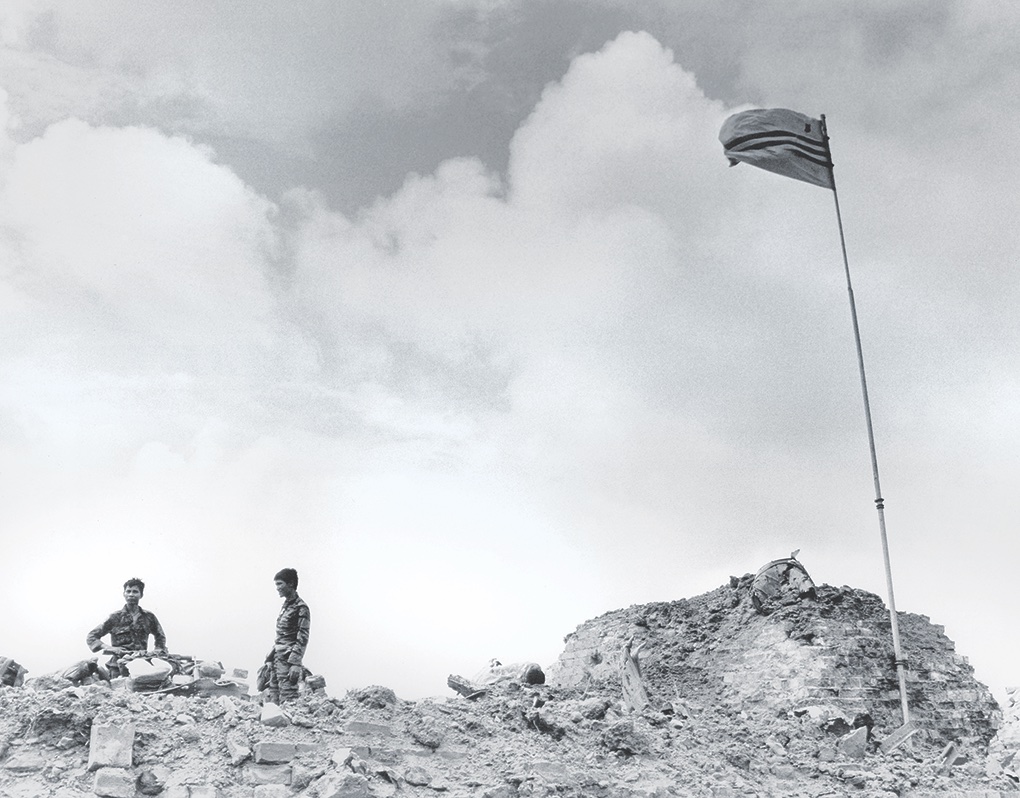
On the night of Sept. 9, Lt. Col. Do Huu Tung, commander of the 6th Battalion, sent a reconnaissance patrol into the citadel. The patrol reported scanty opposition, and Tung launched an attack the following evening. By first light on Sept. 11, a company lodgment was established inside the southeast corner of the fortress. Tung rushed more marines in. Meanwhile, the 1st and 2nd battalions fought their way to the Thach Han River, closing it off for enemy use. The NVA counterattacked, but the marines held on to their hard-earned gains.
To the north, the 3rd and 7th battalions cleared the area of communist forces. On the morning of Sept. 15, the 3rd Battalion forced its way into the citadel. The NVA began a massive artillery bombardment to keep the 3rd Battalion and 6th Battalion apart, but the two units linked up by late afternoon.
On Sept. 16, at 12:45 p.m., the South Vietnamese flag was raised over the west gate of the citadel, signifying the end of 138 days of NVA occupation.
The event was big news worldwide, although some American newspapers, citing the casualties and the battered landscape, called it a Pyrrhic victory. An intercepted communist dispatch blamed the NVA loss on American bombing: “The U.S. had schemed to level this area and turn Quang Tri Town into a land of death with no place for revolutionary forces.”
In South Vietnam, the recovery of the last provincial capital in enemy hands was cause for great rejoicing. On Sept. 20, Thieu visited the Marine Division to congratulate the commander, officers and men. Promotions and decorations were liberally awarded. U.S. Army Maj. Gen. Howard Cooksey, commander of the First Regional Assistance Command, recommended the entire Marine Division for the U.S. Presidential Unit Citation. There is no evidence that the award was officially presented.
Minor attacks to eliminate small pockets of resistance continued, but the battle lines between the two armies stabilized. An airborne adviser observed: “They were like two fighters in the 14th or 15th round. They could hardly do anything but hold on to each other.”
The South Vietnamese pride in rebuffing the largest offensive of the war was diluted by the terms of the Paris Peace Accords, which were signed on Jan. 27, 1973. The agreement allowed more than 100,000 NVA troops to remain within South Vietnam’s borders, placing the country in an untenable position. The Thach Han River, 13 miles south of the DMZ border established by the 1954 Geneva Accords, became the new boundary between the two Vietnams.
The truce gave the North Vietnamese time to reconstitute their battered army. A hostile U.S. Congress added to South Vietnam’s disadvantage by reducing military aid, and Nixon, battered by the Watergate scandal, resigned in disgrace in August 1974. In early 1975, North Vietnam resumed its military campaign to conquer the South. The old revolutionaries in Hanoi were sure the United States would not intervene. This time they were right.
On March 19, 1975, the NVA overwhelmed the ARVN line along the Thach Han River. The defenders fell back, and the enemy immediately occupied Quang Tri city, setting off a chain reaction that swept up cities across South Vietnam. On April 30, 1975, NVA tanks crashed through the gates of Saigon’s presidential palace. The Republic of Vietnam ceased to exist.
During the 1972 battle for Quang Tri city, John Howard was on his second tour in Vietnam, serving as senior adviser with the 6th Airborne Battalion. He was wounded on July 26, 1972, the day before the Vietnamese marines relieved the Airborne Division. He visited Quang Tri in summer 2011. Howard, a retired brigadier general, lives in Carolina Beach, North Carolina.
This article was published in the April 2022 issue of Vietnam magazine.
historynet magazines
Our 9 best-selling history titles feature in-depth storytelling and iconic imagery to engage and inform on the people, the wars, and the events that shaped America and the world.


